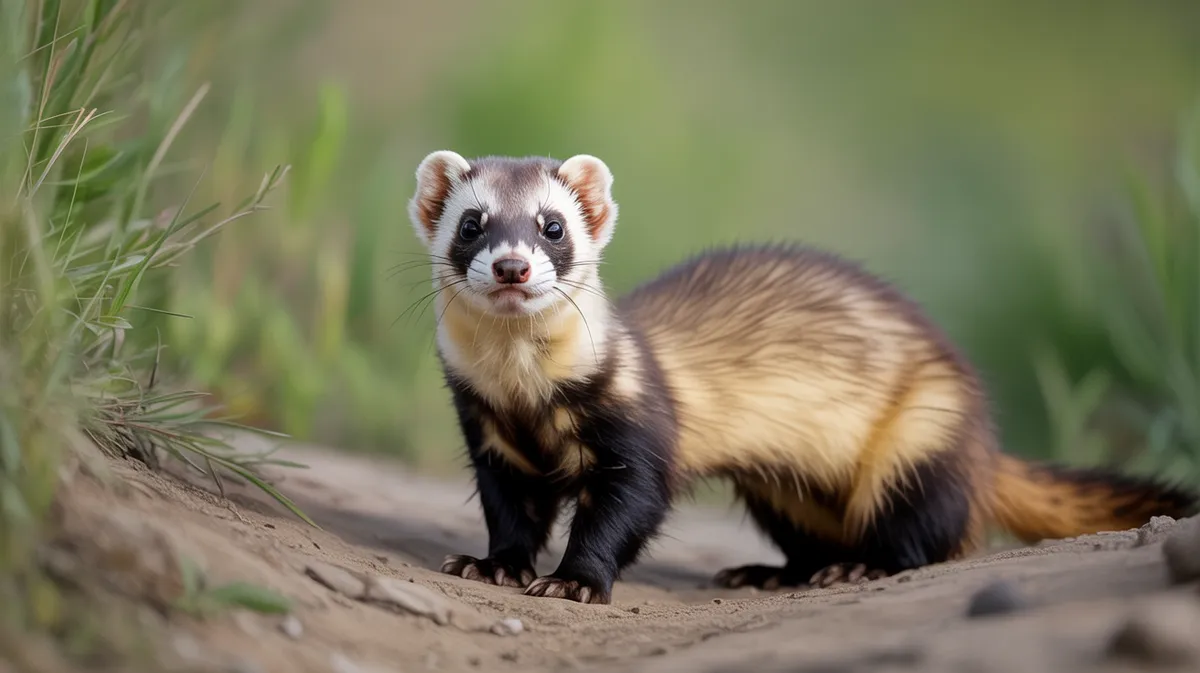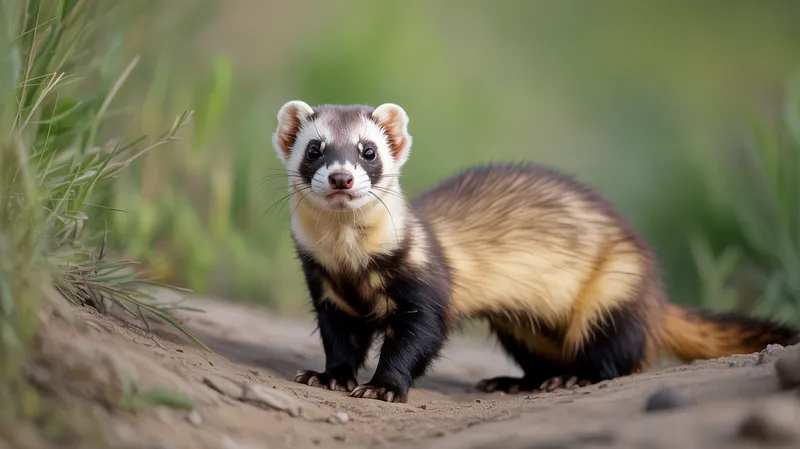
Black-footed Ferret
Mustela nigripes

Meet the Black-footed Ferret
The Black-footed Ferret is a slender, nocturnal mammal native to the grasslands of North America. Characterized by its pale yellowish fur, black markings on its feet, legs, tail tip, and a distinctive mask across its eyes, it is the only ferret species native to North America. Once thought extinct, intensive conservation efforts have reintroduced it to parts of its former range. Black-footed Ferrets are highly specialized predators, relying predominantly on prairie dogs for food and shelter.
Classification
Mammal
Habitat
Temperate grasslands and prairies
Diet
Carnivore
Lifespan
3-4 years in the wild, up to 9 years in captivity
Conservation
Endangered
Weight
650–1,000 grams
📖Fascinating Facts
Prairie Dog Hunters
Black-footed Ferrets rely on prairie dogs for more than 90% of their diet and make their homes in abandoned prairie dog burrows.
Nocturnal Lifestyle
They are mostly active at night, using their keen sense of smell and hearing to hunt underground.
Genetic Bottleneck
All living black-footed ferrets are descendants of a tiny population, making genetic diversity a major concern for conservation.
📋Detailed Description
The Black-footed Ferret (Mustela nigripes) is a slender, elongated mustelid measuring 38–50 cm (15–20 in) in body length, with a tail of 11–15 cm (4.3–5.9 in), and typically weighing between 650–1,000 grams (1.4–2.2 lbs), with males being slightly larger than females. Its fur is pale buff or yellowish-tan, with distinctive black markings on the feet, legs, tail tip, and a characteristic black facial mask. The species has a streamlined body, short legs, and a flexible spine, allowing it to navigate the narrow burrows of its primary prey, prairie dogs. Black-footed Ferrets are nocturnal and crepuscular, spending up to 90% of their time underground in prairie dog burrow systems, which provide both shelter and hunting grounds. Their eyesight is adapted for low-light conditions, and they possess acute hearing and olfactory senses for detecting prey. The species is solitary outside of the breeding season, with individuals maintaining exclusive territories. Lifespan in the wild averages 3–4 years, though individuals may live up to 7–8 years in captivity. The Black-footed Ferret is one of the most specialized carnivores in North America, with over 90% of its diet consisting of prairie dogs (Cynomys spp.), making it highly dependent on healthy prairie dog populations and intact grassland ecosystems.
💡 Did you know?
The species was declared extinct in the wild in 1987, but all existing black-footed ferrets today descend from just seven individuals found in Wyoming.
🔬Research & Sources
Wikipedia Summary
The black-footed ferret, also known as the American polecat or prairie dog hunter, is a species of mustelid native to central North America.
Last Modified: 6/9/2025
🎭Behavior & Social Structure
Black-footed Ferrets are primarily nocturnal hunters, emerging from their burrows at dusk and remaining active throughout the night. They exhibit solitary behavior, except during the breeding season or when females are raising kits. Ferrets patrol their territories, which may overlap with those of other individuals, and use scent marking to communicate presence and reproductive status. Hunting involves stealthily entering prairie dog burrows and ambushing prey in confined spaces. They are capable of killing prey larger than themselves using a swift bite to the neck. Feeding is opportunistic, but they cache surplus food within burrows. Social interactions are generally limited to aggressive encounters over territory or mating opportunities. Kits remain with the mother for several months, learning hunting skills before dispersing. Daily routines are dictated by prey availability and environmental conditions, with ferrets often remaining underground during extreme weather.
👶Reproduction & Life Cycle
The breeding season for Black-footed Ferrets occurs from March to April. They are induced ovulators, with mating involving brief but vigorous encounters. After successful copulation, the gestation period lasts approximately 41–43 days. Females give birth to litters of 1–7 kits (average 3–4) in late May or early June, within prairie dog burrows that serve as natal dens. Kits are altricial at birth—blind, deaf, and nearly hairless—and are entirely dependent on maternal care. The mother nurses the kits for about 30–45 days, after which they begin to eat solid food. Kits emerge above ground at around 6 weeks old and remain with the mother until late summer or early autumn, when they disperse to establish their own territories. Males do not participate in parental care.
🛡️Adaptations & Survival
Black-footed Ferrets have evolved several physical and behavioral adaptations to their subterranean lifestyle and specialized diet. Their elongated, flexible bodies and short limbs enable efficient movement through prairie dog tunnels. Strong jaws and sharp canine teeth are adapted for killing prey in confined spaces. Their fur coloration provides camouflage in grassland habitats, while the black facial mask may reduce glare and enhance visual acuity at night. Acute senses of hearing and smell aid in detecting prey underground. Behaviorally, they exhibit food caching and can survive periods of prey scarcity by reducing activity and metabolic rate. Their reproductive timing is synchronized with prairie dog reproductive cycles, ensuring abundant prey for lactating females and growing kits.
📚Research Sources
🎨Cultural Significance
The Black-footed Ferret holds symbolic significance as a flagship species for North American grassland conservation. Once thought extinct, its rediscovery in the 1980s and subsequent recovery efforts have made it an emblem of successful wildlife restoration. It features in educational programs and conservation campaigns, highlighting the interconnectedness of prairie ecosystems. While not prominent in indigenous mythology or traditional use, its dependence on prairie dogs links it to the cultural landscape of the Great Plains. The ferret’s story has inspired public interest in endangered species and habitat preservation.
🔬Recent Research & Discoveries
Recent research has focused on disease management, particularly sylvatic plague vaccination for both ferrets and prairie dogs, and genetic management to maximize diversity in captive and wild populations. Studies using radio-telemetry and camera traps have improved understanding of ferret movements, survival, and habitat use. Advances in assisted reproduction, such as artificial insemination and cloning (notably the 2020 cloning of 'Elizabeth Ann,' the first cloned Black-footed Ferret), offer new hope for genetic rescue. Ongoing research addresses the impacts of climate change on grassland ecosystems and the long-term viability of reintroduced populations. Conservation genetics, disease ecology, and habitat restoration remain active areas of scientific inquiry.
🎥Wildlife Videos

Saving America's Wild Ferrets from the Plague | WILD HOPE
Black-footed ferrets, North America's only native ferret, still depend on humans for survival. That's why a dedicated team has ...
Nature on PBS

Saving The Black-Footed Ferret in Colorado
Once thought to be extinct, the black-footed ferret remains one of the most endangered mammals in North America. Colorado ...
Colorado Parks and Wildlife

Exploring Wildlife with AI: The Tale of the Black-footed Ferret
Dive deep into the captivating tale of the black-footed ferret, one of North America's most endangered and mysterious mammals.
Exploring Wildlife with AI

Black Footed Ferret
This is a news segment for the show "This American Land." The Black Footed Ferret is the rarest mammal in North America, ...
SargentBoulder

FERRET in Action! Facts about Fast and agile Ferret terrifies snakes, rabbits and squirrels
The fastest and most agile of the mustelid family - the ferret in action! Ferret versus squirrel, rabbits and gophers. Ferret vs rat.
WILDOPEDIA

Releasing Ferrets Into Their Prairie Home | National Geographic
After acclimating to burrow systems and learning to hunt, captive-raised black-footed ferrets are finally prepared to live in the wild.
National Geographic
🌍Habitat Information
The Black-footed Ferret typically inhabits Temperate grasslands and prairies environments. Black-footed Ferrets have adapted to their environments with specialized features and behaviors.
Primary Habitat:
Temperate grasslands and prairies
More detailed habitat information will be available soon.
🛡️Conservation Status
The Black-footed Ferret is currently classified as Endangered. Conservation efforts are crucial for preserving this species for future generations.
Common Threats:
- 🏠Habitat loss and fragmentation
- 🌡️Climate change impacts
- 🎯Hunting and poaching
- 🏭Human-wildlife conflict
⚠️Threats & Conservation Challenges
The primary threats to Black-footed Ferrets are habitat loss, prairie dog population declines (due to poisoning, disease, and land conversion), and sylvatic plague (Yersinia pestis), which affects both ferrets and their prey. Habitat fragmentation limits dispersal and genetic exchange, increasing vulnerability to inbreeding depression. Human activities such as agriculture, urban development, and energy extraction have reduced native grassland habitats to less than 2% of their historical extent. Conservation challenges include maintaining viable prairie dog colonies, managing disease outbreaks, and ensuring genetic diversity in reintroduced populations. Despite intensive captive breeding and reintroduction programs, the global population remains small (estimated at 300–400 wild individuals as of 2023), and the species is classified as Endangered by the IUCN.
🔬Scientific Classification
Scientific Name
Mustela nigripes
Classification Hierarchy
🔍 About Taxonomic Classification
Taxonomic classification is a hierarchical system used by scientists to classify and organize living organisms based on shared characteristics and evolutionary relationships.
The system moves from broad categories (Kingdom) to increasingly specific ones, with each animal's scientific name typically consisting of its Genus and species.
📝Community Notes
Share your observations and insights about the Black-footed Ferret with our community of wildlife enthusiasts.
Join Our Community
Sign in to share your observations and connect with fellow wildlife enthusiasts.
Sign In to ContributeNo community notes yet
Be the first to share your observations about the Black-footed Ferret!
Explore Black-footed Ferret
Select a tab above to learn more about this amazing animal.
📸Photo Gallery
No photos available for this animal yet.
🌟Discover More Wildlife
Continue your journey of discovery with more fascinating animals from our database
